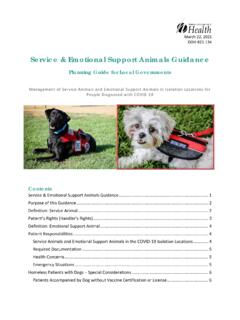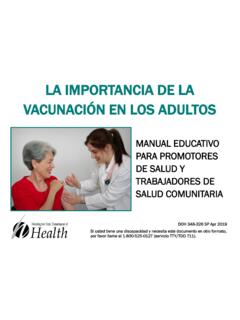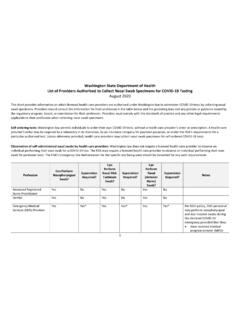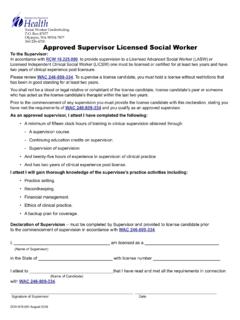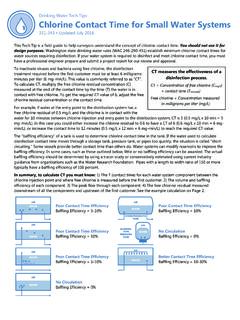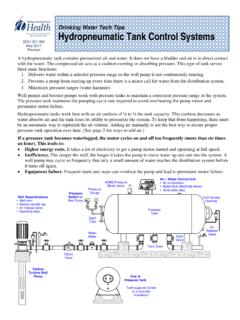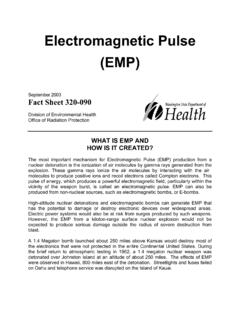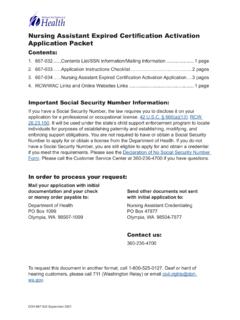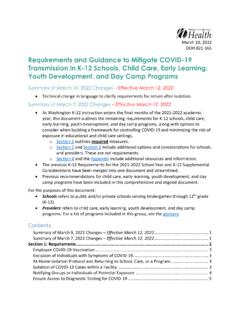Transcription of The Well Child Exam - Washington State Department of Health
1 The Well Child ExamKeeping Kids at the Top of Their Game!Presented by: Jared Papa, MPAS, PA-CPediatric PATreasure Valley Pediatrics Ontario, OregonE-mail: 208-373-1754I hope you leave with: A Vision of the value of the Well Child Exam (WCE) Discovery of a some of the many conditions the WCE can catch early A desire to encourage families to follow the American Academy of pediatricians (AAP) guidelines for WCEs1 month old: Claw Hand Injury to C8 and T1 nerve roots Often due to traction on an abducted arm Paralysis of forearm and hand Presents as a claw hand Most symptoms resolve with PT Some treated surgically Few result in permanent impairment Can catch and monitor at WCEK lumpke sPalsyThe Well Child Exam The Why1-Maximize Child s potential Monitor normal and abnormal development The Individuals with Disabilities Education Act (IDEA)
2 Mandates early identification and intervention for developmental disabilities2-Early disease detection3-Promote disease prevention4-Provide Anticipatory Guidance Estimated 16% of children have developmental and/or behavioral disorders 70% of these children notidentified until afterentering schoolWell Child Exam The WhatWell Child Exam The WhenThe American Academy of Pediatrics (AAP) Recommends:Routine Surveillance at: Prenatal Newborn 3 to 5 days By one month (2 weeks) 2 months 4 months 6 months 9 months 12 months 15 months 18 months 24 months 30 months Then yearly (3, 4, 5, etc)Formal Screening tools: When surveillance indicates risk Developmental Screening tool at: 9 month WCE 18 month WCE 30 month WCE (or 24 month) Other tools: Completed at specific ages: Hearing Newborn and 4 years Lead 12 months Cholesterol 9-11 and 17 to 21 years Tobacco/Drug/Alcohol 11 21 years Depression 12 to 21 years Miguel Newborn WCEThe Newborn Visit AAP Recommends all babies have: Comprehensive physical exam within 12 to 18 hours of delivery Primary care provider (PCP) follow-up within 3 to 5 days of life and 48 to 72 hours from hospital discharge Jaundice one of many things looked for at initial WCEs Elevated bilirubin (Hyperbilirubinemia) causes yellow discoloration of skinand/oreyes Total Bilirubin (TB) Screening.
3 Completed in hospital soon after birth May be repeated by PCP at the 3 to 5 day visit Kernicterus: Severely high newborn bilirubin: TB >25mg/dL Risk for bilirubin-induced neurologic dysfunction (BIND) Bilirubin crosses blood- brain barrier and binds to brain tissue Kernicterus is the chronic and permanent result of BIND Cerebral palsy, hearing loss, gaze abnormalityNewborn Jaundice -DangersHyperbilirubinemia Treatment Phototherapy The Blue Light Most common intervention to treat & prevent severe hyperbilirubinemia Infant s skin exposed to blue light Blue light breaks down bilirubin so easier to eliminate in stool and urine Done inpatient or at home for healthy term infants (>38 weeks GA) In intermediate risk infants, phototherapy can be achieved by placing baby in indirect (filtered)
4 Sunlight 15 minutes 3 times daily Exchange transfusion Emergency procedure to reduce bilirubin Used if severe hyperbilirubinemia, high risk factors, or poor response to phototherapyBilirubin risk calculator: Prevention Keep Feeding! Breast milk preferred, formula also good Promotes elimination of bilirubin through stool and urine Adequate feeding: Infant eating every 2 to 3 hours Infant having at least six wet diapers per day Color of stool should change from dark green to yellow Infant should seem satisfied after feedingMiguel at 2 Weeks2 Week Old WCE The PKU Test Checking for Inborn errors of metabolism PKU (Phenylketonuria) is one of many Deficiency of enzyme phenylalanine hydroxylase Results in accumulation of phenylalanine and intellectual disability If not caught early can lead to irreversible organ injury or death If diagnosed and corrected before organ/ brain damage Child may have normal life All 50 states have mandatory newborn screeningWashington State Newborn ScreeningMiguel 2 Months Old2 Month Old WCE Safe Sleep Sudden Infant Death Syndrome (SIDS) Definition.
5 A sudden unexpected death of an infant before age 1 that occurs in their sleep for an unknown reason Sleeping on back reduces chances of SIDS SIDS deaths per 1,000 live births in 1980 SIDS deaths per 1,000 live births in 2010 Side sleeping unsafe 5x greater risk compared to back sleeping Safe vs Unsafe: This is what you see:Miguel s now 4 Months old AAP recommends screening for Developmental Dysplasia of the Hip (DDH) Newborn, 2 wks, 2 mos, 4 mos, 6 mos, 9 mosand 1 yrof age DDH -Spectrum of conditions involving Abnormal relationship b/t the femoral head and acetabulum Hip instability found in 1/1000 live birthsMiguel s 4 Month Old WCE Symptoms Newborns will be asymptomatic What to look for How infant holds the hips Skin folds asymmetric Hip abduction asymmetric Positive Galleazzisign Shortening of one thigh Provoking maneuvers Barlow OrtolaniDevelopmental Dysplasia of the Hip (DDH)DDH Treatment Brace < 10 mos.
6 Of age =Pavlikharness > 10 mos. of age = Hip abduction brace If not diagnosed before 2 years of age often require surgical treatmentMiguel s 6 months old Ht: inches Wt: 13 lbs Head circumference: 43 cm Miguel does look thinnerFailure to thrive Usually under 3 years of age Growth Chart Evidence: Weight below 2nd percentile Weight for height < 2nd percentile Best identifier for under nutrition Treatment: Breast feeding every 2 to 3 hours High calorie formulas: Neosure Older Child : 5 sit-down meals/day, cook foods in oil/butter Pediasure Consult a dietician Calculate catch up calories Miguel is 9 months oldDevelopmental MilestonesFive main domains1-Gross Motor2-Visual-motor/Fine Motor3-Language/Communication4-Social-ad aptive/Personal Social5-Cognitive/Problem solving Generalized rules for neurodevelopmental maturation Used to form an anticipated developmental trajectoryWCE Pop Quiz Gross Motor2 Months4 Months6 Months9 MonthsA-Sits unsupported, transfers objectsB-Holds head midline, smiles sociallyC-Raises body using arms, LaughsD-Crawls, throws objectMiguel s 9 Month Old ASQ-335 ASQ-3.
7 30 questions divided into 5 areas of development1-Communication2-Gross Motor3-Fine Motor4-Problem Solving5-Personal-Social Ages and Stages Questionnaire (ASQ-3), birth to 5 ASQ-3 Scoring353 Miguel at 12 months of age Regular screening for anemia is done at 12 months Can be done before or after based on risk assessmentHematocrit Normal Levels:Miguel s Hematocrit: 28%WCE: 12 month old Miguel Hemoglobin or HematocritAgeHct1 year to 6 years 30% to 40%Miguel 12 month old WCEIron deficiency anemia treatment: Supplemental Iron: Fer-in-Sol Drops 75mg (15mg Fe) 3 mg/kg, usually 1 dropper once daily Recheck @ 15month old WCE Iron stores generally replenished with 3 months of therapyMiguel is 15 Months Old Majority physiologic and considered a variation of normal in toddlers Hallmark is symmetrical and painless bowing Almost always corrects spontaneously Typically resolves by age 3 Treatment Observation Parental education, correction with time Minority are pathologic -When to suspect pathologic cause?
8 Unilateral Pain Previous trauma/fractureGenu Varum(bowed legs)Miguel is 18 months old: What should his language level be at 18 months? A-Says only Mama and Dada B-Can use two word sentences C-Simply babbles and makes sounds D-Speaks 7 to 10 wordsMiguel s 18 month old WCE: Language delay is the most common 1stsign of an Autism Spectrum Disorder (ASD) Autism screening: Recommended at 18 & 24 months Modified Check list for Autism in toddlers -Revised(MCHAT-R) Pervasive Developmental Disorders Screening test-II (PDDST-II)Scoring: 2,5,12 If Yes = ASD risk All other questions if answered No = ASD risk Low Risk = 0-2 Medium Risk = 3-7 High Risk = 8-20He has a new baby sister HURRAYM iguel is 2, Wahoo! Or maybe not?
9 50%-80% of 2 to 3 year olds throw tantrums (Normal) 20% on a daily basis Most resolve by 4 Remain calm, acknowledge Child s feelings Help learn self regulation Give Child choices Any correlations? Hunger, Sleep, Change in family, Unmet needs Teach & praise desired behaviors Consistent expectations and restrictions Avoid over punishing Distraction, redirection Time out, restrain if in dangerMiguel at 2 Temper Tantrums!Miguel is 4and ready to start preschool An exam of the eye is performed at every WCE Vision screening occurs at the Pediatrician s office at each WCE visit starting from age 3 Visual acuity chart and/or photo refraction device Miguel s results:OD: 20/50, OS: 20/70 & OU: 20/50 Miguel is 4 Early Childhood WCE 1 to 4 years oldStrabismus Meet JackMiguel is 10 and Starting Middle School Asserting power over another through aggression or repeated targeting through emotional, social or physical means National Center for Education Statistics and Bureau of Justice Statistics reported about 21% of students ages 12-18 experienced bullying Bullying Approaching the Victim.
10 Only 50% of victims confide in anyone Show empathy I m sorry, this must be really hard! Inquire Do other children frequently bother you? How? Have you seen other children being bullied? What do you do during recess or lunch? Do you frequently go to school nurse for physical complaints? Approaching the Bully: Label behavior as bad, not the Child as bad Label behavior as harmful to victim and bully Bullying is serious behavior with consequences Ask about concerns at home and schoolBullying Reassure victim that it will STOP! Whole-School approach School wide rules, teacher and student training Social worker counseling for victim and bully Eliminate unsafe areas with adult supervision Bystander activation Empowering and expecting intervention Parental involvement Work with school Limit glamorizing violence Check devises for cyberbullying -InterventionMiguel is 12 He s gained weightObesity A Growing Problem 17% of children 2 to 19 years old ( million) CDC: Nutrition, Physical Activity and Obesity: Data, Trends and Maps The Dangers: Decreased physical capacity Cholesterol, Heart Disease, Diabetes Poor self image The cause.
